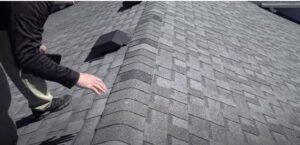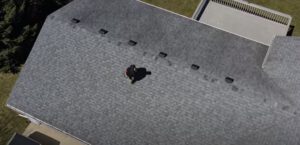 A home’s roof is its first line of defense against the elements. But over time, this protective barrier may show signs of wear and tear. Understanding these signs of roof damage can save homeowners from costly repairs in the future.
A home’s roof is its first line of defense against the elements. But over time, this protective barrier may show signs of wear and tear. Understanding these signs of roof damage can save homeowners from costly repairs in the future.
Visible Aging and Wear
One common sign of roof damage is visible aging and wear. As a roof ages, it tends to lose its granules, causing bald spots. You might also notice curling or buckling shingles. These are indications that the shingles have passed their life expectancy and need replacing.
Aging and wear can also be seen in other parts of your roof, such as the flashing and gutters. If you notice any rust, holes or cracks in the flashing or gutters, it’s time to call a professional for repairs.
Leaks and Water Damage
One of the more apparent signs of roof damage is a leak. If you see water stains on your ceilings or walls, it might be due to a leak in your roof. Additionally, if you notice a musty odor in certain rooms, it may be caused by a leak that’s led to mold growth.
Leaks are caused by several different issues, such as broken or missing shingles, improper installation of flashing around vents and chimneys, or deterioration of the roof deck. If you notice any of these issues, call a professional immediately to assess your roof’s condition.
Snow and Ice Damage
Harsh winter weather can do serious damage to your roof. Snow and ice can freeze and thaw in your roofing materials, leading to cracks that can result in leaks. You should also check for any ice dams that may form near the edge of your roof, as these can cause water to collect on your roof and seep through weak points.
Damaged Flashing
Flashing is designed to protect the crevices in the roof line, where it meets up with vents, skylights, and chimneys. Damaged or missing flashing could lead to water seeping into the house, causing damage.
When flashing has been damaged, it should be replaced as soon as possible to protect your roof and walls from water damage. The best way to prevent this from happening is to inspect your flashing regularly for signs of wear and tear, and to replace it when necessary.
Gutter Clogs
Clogged gutters are one of the most common causes of roof damage. When gutters are clogged with leaves and debris, they can’t do their job properly and can quickly cause water to back up and leak into the house. This is especially true during heavy rainfall or when snow melts. To prevent this from happening, it’s important to check your gutters regularly for any signs of blockage. If you find that they are clogged, then you should clean them out as soon as possible.
Algae and Moss Growth
Algae or moss growth on the roof is a clear sign of potential damage. Algae and moss tend to hold onto water, keeping your roof damp and increasing the risk of rot and deterioration.
 The growth of algae and moss can also cause dark streaks to form on your roof, making it look unsightly and taking away from the overall curb appeal.
The growth of algae and moss can also cause dark streaks to form on your roof, making it look unsightly and taking away from the overall curb appeal.
To get rid of these growths, you can either scrub them away or apply a mixture of water and bleach to kill them off. Once they’ve been removed, be sure to keep up with regular maintenance and cleaning to prevent their return.
Damage from Storms
If your area has experienced a severe storm, then your roof could be at risk of damage. High-velocity winds can cause shingles to lift or tear off, leaving holes in the roof that can leak if left unrepaired.
Heavy rains and flooding can also damage your roof, as the excess water can seep through small cracks or holes in the shingles. If you live in an area prone to storms and flooding, it’s important to conduct regular inspections of your roof to make sure there are no signs of damage.
Conclusion
Regular inspection of your roof is key to maintaining its condition and longevity. By recognizing these signs of damage early, you can save yourself the hassle of larger repairs or even a roof replacement down the line.